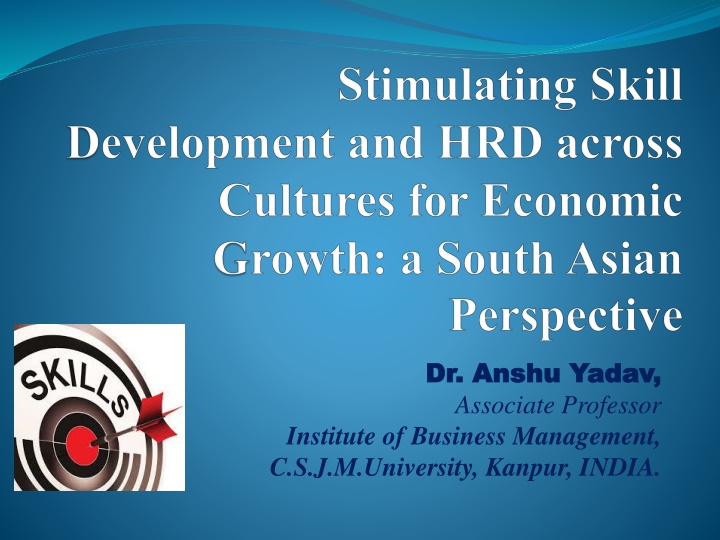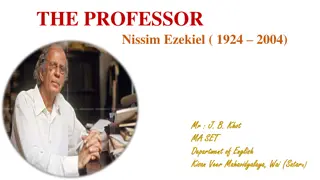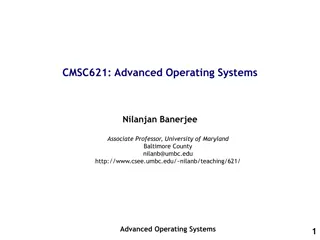Associate Professor
Highlighting the critical issues of skill gaps in education and workforce development, emphasizing the impact on employability, productivity, and economic growth in SAARC nations. The study aims to explore HRD environments, identify skill gaps, and propose strategies for improvement.
Download Presentation

Please find below an Image/Link to download the presentation.
The content on the website is provided AS IS for your information and personal use only. It may not be sold, licensed, or shared on other websites without obtaining consent from the author.If you encounter any issues during the download, it is possible that the publisher has removed the file from their server.
You are allowed to download the files provided on this website for personal or commercial use, subject to the condition that they are used lawfully. All files are the property of their respective owners.
The content on the website is provided AS IS for your information and personal use only. It may not be sold, licensed, or shared on other websites without obtaining consent from the author.
E N D
Presentation Transcript
Dr. Dr. Anshu Anshu Yadav Associate Professor Yadav, , Institute of Business Management, C.S.J.M.University, Kanpur, INDIA.
Introduction Education and skill building can make a great difference in achieving economic, development. The quality and mode of imparting education is under criticism due to overemphasis on academic education and less focus on vocational education. The education received by young people does not reflect the needs of the labour market, thereby making them unemployable. Youth unemployment and underemployment is specially pressing in SouthAsia. environmental and social
According to McKinseys Education to Employment report, 70% of educators surveyed believe graduates are prepared for the job market. On the other side, less than 50% of employers and young graduates agree.
Objectives of the study To explore education and HRD environment in the SAARC nations To advance certain skill development issues and the challenges surrounding it To identify skill gap in the young workforce. To study the role of socio- political constraints in underutilisation of workforce potential including women. To suggest strategies for improved HRD
Skill gap: challenge at 3 levels For Skills gaps limit employability and deprive individual of the opportunity to improve his or her living conditions. At the company level, Skills gaps limit productivity, which can lead to higher costs and lower quality, and reduce the company s growth prospects. At the country level, Skills gaps limit the nation s reduce economic and social development potential. the individual, an competitiveness and
The Global Competitiveness Index 20152016 Rankings Among the members of SAARC India leads the way at 55th, Sri Lanka (68th, up five). Nepal (100th, up two), Bhutan (105th, down two), Bangladesh (107th, up two), and Pakistan (126th, up three) since 2007 only Nepal has managed to progress significantly (14 places gained); Pakistan lost 34 places during that period and India, despite leapfrogging 16 places this year, still ranks seven notches lower than it did in 2007.
Skill development climate and indicators in SAARC nations The skill development environment in South Asia can be studied with the help of following indicators: Quality of Primary and Secondary education system Higher education and training Specialised research and vocational training services
Quality of education system Primary education has focussed on three primary components: i) universal access and participation, all SAARC countries have legislation on free and compulsory education most of the countries, other than Afghanistan and Pakistan (Alam, 2015), have already or almost reached universal enrolment at primary level Several schools in Nepal have instigated a school mapping procedure whereby teachers and children draw up a map of the community and use it to trace which children are in school and which are not. Also in Bhutan and India (with the Right to Education Act) schools have responsibility for reaching out to children in the school s vicinity who are not in school. ii) universal retention and progression, India, Pakistan and Bangladesh account for majority of out-of-school children Sri Lanka and Maldives have relatively small number of out-of-school children iii) universal achievement and completion On average, children in South Asia spend only 11.3 years of formal schooling from primary to tertiary education compared with the average in developed countries of 16.4 years
Challenges in Primary and Secondary education Quality related deficiencies Lack of teacher and community participation Centrally controlled, hierarchical system Inadequate resources Poor infrastructure Social barriers Wide school enrolment and learning gaps Gender gaps in enrolment
Higher education and training In India, the Gross Enrollment Ratio (GER) for higher education has shown significant improvement from 19.4% in 2010-11 to 23.6% in 2014-15 This increase in number in respective countries is also due to greater participation of females in tertiary education, especially in countries like Pakistan andAfghanistan There is a high desire to get a foreign degree in the youth
Higher education and training The institutional framework in most countries is centred on a leading organisation (such as UGC in India) New funding models are being identified to relieve the pressure on government funding agencies. The least developed countries are also being helped through foreign aid Countries like India, Afghanistan, Pakistan have recognized the role of private sector in higher education Emerging concept of Corporate Universities Bangladesh and
Challenges (HET) Poor funding Lack of outcome based education Lack of autonomy of universities Ineffective private sector participation Topographic barriers Lack of emphasis on curriculum modification Poor Research 81 young women are enrolled for every 100 young men in South Asia (UNESCO Institute for Statistics, 2015)
Specialised research and vocational training services Vocational education is less valued in comparison to academic education Vocational education is not built- in into the education system There is a need to establish sustainable education systems using ICT for rapid capacity building Skill building agenda is not linked to country specific strengths
Specialised research and vocational training services Sri Lanka- Every year an estimated 140,000 students complete general education without having acquired job-related skills Bangladesh- Vulnerable employment Bangladesh Maldives- The geographical isolation and lack of sufficient teachers is the greatest challenge for the Maldives. Expatriate employment is on the rise Nepal- Nepal has a unique topography and a large rural population. Nepal is the lowest among the SAARC nations in terms of Human Development Index Bhutan- Vocational training is seen as a career path for low- performing students and school dropouts India- Low levels of enrolment in technical and vocational education is quite high in
Challenges (Vocational education) Non availability of country specific vocational courses No integration of technical and vocational education with general education Low levels of enrolment in technical and vocational education Lack of coordination between industry and academia Low social status to manual work High cost of technical and vocational education Poor availability of subject experts Poorly developed ICT and online courses
Gender Parity in Education South Asia remains the most gender-unequal region in the world in the context of education (UNICEF) Cultural and social beliefs create multiple disparities that debar girls from their right to education. Maldives enrolment achievement and gender parity in primary education are among the highest in the world. Sri Lanka has provided significant state support to education; hence there is equal participation of girls and boys in primary education and beyond. The number of females attending certain universities has in fact surpassed the number of males.
Gender Parity in Education India is close to gender parity in education as per UNESCO s Education for All Global Monitoring Report, 2015. The girls- to-boys ratio in primary classes is 1.02 while that in secondary schools is 0.94. Gender Parity Index (GPI), in higher education is 0.93 (AISHE 2014-15(P)). One often cited example of a successful incentive scheme is the Female Stipend Programme in Bangladesh whereby all rural secondary age girls are eligible for a monthly stipend in return for 75 per cent attendance rate, 45 per cent attainment in examinations and an agreement not to marry until they are eighteen (Mujahid-Mukhtar, acknowledged that this programme has been a major contribution for Bangladesh having achieved parity between girls and boys in terms of access to education. 2008, p.25). It is largely
Best Practices in Skill development All over the world there is a growing concern for skill shortages and employers are continuously warning nations of skill gap. Only 2.3% of the workforce has had formal skills training in India, compared with 80% in Germany Countries such as Austria and Germany, with relatively high levels of engagement in vocational learning, have among the lowest rates of unemployment
Best Practices in Skill development Countries like South Korea, Japan, Singapore and Hong Kong have primary and secondary education systems that value effort above inherited intelligence Germany's dual vocational education model to train personnel is contributing to its real economy. It pairs hands-on learning with classroom learning to give young people an advantage in the workforce.
Best Practices in Skill development The Apprenticeship training system in Austria offers an ideal combination of practical skills, theoretical knowledge, and important key qualifications to make way for skill development. In Switzerland, the apprenticeship programs include a combination of classes at a vocational school and practical, work-based learning at a company where apprentices are employed.
Suggestions expand opportunities so as to capitalise on the demographic dividend regional cooperation for economic growth must be promoted Design local labour force-oriented initiatives Promote labour intensive industries Focus more on technical and soft skills benchmark best practices in other advanced countries as per the unique requirement of individual nations design suitable exchange programmes to learn from one another and promote Human Resource Development Develop the philosophy of life-long learning for continuous growth and knowledge based development Develop a common framework for skills and qualifications Promote industry-academia interface education, skill building, health and employment























